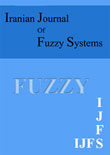فهرست مطالب

Iranian journal of fuzzy systems
Volume:4 Issue: 2, 2008
- تاریخ انتشار: 1386/10/11
- تعداد عناوین: 10
-
-
Page 1We dedicate this issue to the memory of Professor Zdzislaw Pawlak, the father of rough sets, and lead with an appreciation by his friend and colleague, Prof. Witold Pedrycz.
-
Page 2Professor Zdzislaw Pawlak was born on November 10, 1926 in Lodz, Poland. He started his studies in Electrical Engineering at Lodz University of Technology and then continued them in the area of telecommunication at the Warsaw University of Technology. He completed his MSc in 1951, PhD in 1958 at the Institute of Fundamental Technological Research of the Polish Academy of Sciences. He received his habilitation (DSc) from the Institute of Mathematics of the Polish Academy of Sciences. Throughout his career, Professor Pawlak was associated with the Warsaw University - a premiere educational and research institution in Poland and the Polish Academy of Sciences. Professor Pawlak was at a forefront of many fundamental and far reaching developments in computer science. He was active pursuing foundations of modeling DNA (which as today is referred to as molecular computing) and formal computer architectures radically different from the concepts of von Neumann and Turing. His important and far-reaching contributions are in knowledge representation systems, information retrieval, conflict analysis, and models of computing. He is widely known as a father of rough sets – the concept he put forward in the early 1980s.The idea which was simple yet revolutionary, easy to grasp yet far reaching in terms of its various implications in science and engineering. There has been a genuine flurry of activities when the research community enthusiastically embraced the very idea, moved forward with it, developed interesting and useful generalizations and exercised ingenuity in coming up with innovative applications of rough sets. Rough sets have opened a new avenue of perceiving granularity of information, processing it and exploiting this fundamental concept in knowledge engineering, data mining, and intelligent systems, in general. Those of us, who were privileged to know him personally, were highly impressed by his character, modesty, wit, and a genuine sense of humor. Those of us, who learned about his ideas, viewed him as a superb scientist, man of vision and an innovative thinker. To all of us he was a truly outstanding human being. He will be missed very dearly. What we are confident about is that his innovative ideas, superb innovative research, his inspiration will stay with us forever and the area he has initiated will be vigorously advancing in the years to come.
-
Page 3We use the basic binomial option pricing method but allow some or all the parameters in the model to be uncertain and model this uncertainty using fuzzy numbers. We show that with the fuzzy model we can, with a reasonably small number of steps, consider almost all possible future stock prices; whereas the crisp model can consider only n + 1 prices after n steps.
-
Page 15In this paper, we study the finitely many constraints of fuzzy relation inequalities problem and optimize the linear objective function on this region which is defined with fuzzy max-average operator. A new simplification technique is given to accelerate the resolution of the problem by removing the components having no effect on the solution process. Also, an algorithm and one numerical example are offered to abbreviate and illustrate the steps of the problem resolution process
-
Page 31There are several methods for solving fuzzy linear programming (FLP) problems. When the constraints and/or the objective function are fuzzy, the methods proposed by Zimmermann, Verdegay, Chanas and Werners are used more often than the others. In this note, we investigate Zimmerman method (ZM). In this method, the main objective function is added to the constraints as a fuzzy goal and the corresponding linear programming (LP) problem with a new objective () is solved. When the corresponding LP has alternative optimal solutions (AOS), this method may not always present the "best" solution. Two cases may occur: may have different bounded values for AOS or be unbounded. Since all of the AOS have the same, they have the same values for corresponding LP. Therefore, unless we check the value of for all AOS, it may be that we do not present the best solution to the decision maker (DM); it is possible that is unbounded but ZM presents a bounded solution as the optimal solution. In this note, we propose an algorithm for eliminating these difficulties.
-
Page 47We study interior operators and interior structures in fuzzy setting. We investigate systems of “almost open” fuzzy sets and the relationships to fuzzy interior operators and fuzzy interior systems.
-
Page 57Notions of strongly regular, regular and left (right) regular \gamma-semigroups are introduced. Equivalent conditions are obtained through fuzzy notion for a \gamma-semigroup to be either strongly regular or regular or left regular.
-
Page 69The concept of right (left) quotient (or residual) of an ideal by an ideal of an L-subring of a ring R is introduced. The right (left) quotients are shown to be ideals of. It is proved that the right quotient of an ideal by an ideal of an L-subring is the largest ideal of such that. Most of the results pertaining to the notion of quotients (or residual) of an ideal of ordinary rings are extended to L-ideal theory of L-subrings
-
Page 83In this paper, we purposefully study some properties of the near SR-compactness in L-topological spaces, where L is a fuzzy lattice. The near SR-compactness is a kind of compactness between Lowen’s fuzzy compactness and SR-compactness, and it preserves some good properties of compactness in general topological spaces.
-
Page 89In this paper, the concept of countably near PS-compactness in L-topological spaces is introduced, where L is a completely distributive lattice with an order-reversing involution. The countably near PS-compactness is defined for arbitrary L-subsets and some of its fundamental properties are studied.

